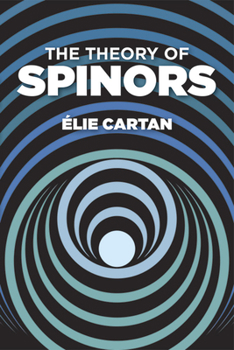The Theory of Spinors
Select Format
Select Condition 
Book Overview
Describes orthgonal and related Lie groups, using real or complex parameters and indefinite metrics. Develops theory of spinors by giving a purely geometric definition of these mathematical entities. Covers generalities on the group of rotations in n-dimensional space, the theory of spinors in spaces of any number of dimensions and much more.
Format:Paperback
Language:English
ISBN:0486640701
ISBN13:9780486640709
Release Date:February 1981
Publisher:Dover Publications
Length:192 Pages
Weight:0.60 lbs.
Dimensions:0.7" x 5.6" x 8.2"
Customer Reviews
4 ratings
translated from French
Published by Thriftbooks.com User , 14 years ago
We have Weyl, Pauli, Dirac and Cartan to thank for our modern theory of groups in physics. This book published in 1937 has none of the later Lie algebra representations of the Cartan generalization of groups and thus, like Weyl's similar book may deceive the reader into thinking he understands when he has only a rough and not very even introduction to these groups. This book doesn't reach much higher than SU(2), SO(3) and the Dirac U(1)*SU(2)*SU(2). The standard model of physics deals with the symmetry breaking of SU(5) ( the Cartan A_4 group) to U(1)*SU(2)*SU(3). The Lie algebras and irreducible Cartan representations of such higher symmetries will demand the student read further than this text. So this book is an historical introduction that gives the starting basis for the mathematics needed by modern students in physics and chemistry.
The most important book that I have ever read
Published by Thriftbooks.com User , 15 years ago
This is also the most difficult book that I have read, it is poorly written. Everybody that I have recommended it to has given up on it. There is scarcely a page in this book that when properly understood is not a key to understanding something in physics. The second chapter on multivectors is worth more than every book that I have read on vectors. Unless things have changed since I taught physics, most people who use vectors have a shallow knowledge of them. One example is the bivector, which we have been taught are axial vectors that are somehow different from regular vectors, polar vectors. Actually they define planes and the so-called axial vector is perpendicular to the plane. In standard physics, nothing happens along the axial vector, e.g. rotation or magnetic field, because the action takes place on the plane of the bivector. It is also interesting that each of the four Maxwell equations is a different type of multivector. And it seems to me that the search for a magnetic charge is futile because the Maxwell equation would require it to be a trivector, known to most people as a triple scalar product. This would require a single number to change sign when you go from a right to left-handed coordinate system. This book is a case of very hard work paying off. What is really needed is a rewrite of this book in more comprehensible form.
Masterpiece based on the original lecture notes of Cartan
Published by Thriftbooks.com User , 22 years ago
This book is a great work on the subject of spinors. Since it is based solely on Elie Cartan's work, the termonology and wording reflects that of the transition coming out of the Post-Victorian math era (i.e., when quaternions and the more abstract mathematics where used for applied calculations in physics, which have been replaced with scalars and vectors). The geometrical definition layed down in the third chapter makes this a very comprehensive book for the newcomer to the subject. Quote page 42., "A spinor is thus a sort of "directed" or "polarized" isotropic vector; a rotation about an axis through an angle of 2pi changes the polarization of this isotropic vector."
Review of theory of spinors
Published by Thriftbooks.com User , 24 years ago
This is an excellent introductory book on spinors, the basic mathematical object used to represent particles with spin.The author begins by defining the spinor as a form of a square root of a 3 dimensional null vector. Scalars, vectors and tensors are then described by their properties under simple geometrical transformations such as reflection and rotation. The author then represents vectors as 2x2 matrices. The transformational properties of spinors are defined by their relation to vectors and tensors under these same simple transformations. The author then shows how spinors are useful for finding the irreducible representations of the rotation group. These concepts are then extended to higher dimensional spinors. Specific applications are shown for Laplace's equation, the Dirac equation and to general relativity. The is an introductory, inexpensive, brief and easy to read book. The book also covers a fair amount of ground. It is an excellent first book for the subject. It does not contain modern developments in the field or some elements of the current notational system for representing spinors. Yet, for me it was the first book that gave me a sense of really understanding the significance of the Dirac equation and quantum physic's concept of spin.




